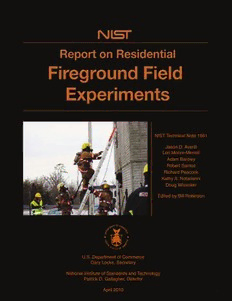
Report on Residential Fireground Field Experiments PDF
Preview Report on Residential Fireground Field Experiments
NISTTechnical Note 1661 Jason D.Averill Lori Moore-Merrell Adam Barowy Robert Santos Richard Peacock KathyA. Notarianni Doug Wissoker Edited by Bill Robinson U.S. Department of Commerce Gary Locke, Secretary National Institute of Standards and Technology Patrick D. Gallagher, Director April 2010 1 2 April 2010 NISTTechnical Note 1661 Report on Residential Fireground Field Experiments Jason D.Averill Lori Moore-Merrell Adam Barowy Robert Santos Richard Peacock KathyA. Notarianni Doug Wissoker Edited by Bill Robinson U.S. Department of Commerce Gary Locke, Secretary National Institute of Standards and Technology Patrick D. Gallagher, Director 3 Certaincommercialentities,equipment,ormaterialsmay beidentifiedinthisdocumentinordertodescribean experimentalprocedureorconceptadequately.Such identificationisnotintendedtoimplyrecommendationor endorsementbytheNationalInstituteofStandardsand Technology,norisitintendedtoimplythattheentities, materials,orequipmentarenecessarilythebestavailable forthepurpose. 4 NationalInstituteofStandardsandTechnologyTechnicalNote1661, 104pages(March2010) CODEN: ProducedwiththeCooperationof ProducedwiththeCooperationof MontgomeryCounty FairfaxCounty FireandRescue FireandRescue ChiefRichardBowers ChiefRonaldMastin FundingprovidedthroughDHS/FEMAGrantProgramDirectorateforFY2008 AssistancetoFirefightersGrantProgram–FirePreventionandSafetyGrants (EMW-2008-FP-01603) 5 6 Table of Contents Abstract ................................................................................................9 ResponseTimeAssumptions..............................................................28 ExecutiveSummary..........................................................................10 Part3:RoomandContentsFires....................................................29 Background........................................................................................12 FuelPackagesfortheRoomandContentsFires..............................29 Problem ..............................................................................................13 ExperimentalMatrixforRoomandContentsFires............................30 ReviewofLiterature..........................................................................14 ProcedureforMinimizingtheEffectofVarianceinFireGrowthRate ..........31 PurposeandScopeoftheStudy....................................................16 AnalysisofExperimentalResults..................................................33 ABriefOverviewofFireDepartmentFiregroundOperations....17 Time-to-taskAnalysis..........................................................................33 TheRelationofTime-to-TaskCompletionandRisk..........................18 DataQueries........................................................................................33 StandardsofResponseCover............................................................18 StatisticalMethods-TimetoTask......................................................33 Part1:PlanningfortheFieldExperiments....................................20 RegressionAnalysis............................................................................33 Part2:Time-to-TaskExperiments..................................................24 MeasurementUncertainty ..................................................................34 FieldExperimentMethods ..............................................................21 HowtoInterpretTime-to-TaskGraphs................................................34 FieldSite..............................................................................................21 Time-to-TaskGraphs ..........................................................................35 OverviewofFieldExperiments ..........................................................22 Part4:FireModeling ........................................................................43 Instrumentation....................................................................................22 TimetoUntenableConditions:ResearchQuestions ........................45 SafetyProtocols ..................................................................................23 FireModelingMethods........................................................................45 CrewSize ............................................................................................24 FireGrowthRates................................................................................46 DepartmentParticipation ....................................................................24 FractionalEffectiveDose(FED)..........................................................47 CrewOrientation..................................................................................24 ResultsfromModelingMethods ........................................................48 Tasks....................................................................................................25 InteriorFirefightingConditionsandDeploymentConfiguration........49 DataCollection:StandardizedControlMeasures..............................27 PhysiologicalEffectsonFirefighters:ComparisonbyCrewSize........50 TaskFlowChartsandCrewCueCards ............................................27 StudyLimitations..............................................................................51 Radiocommunications........................................................................27 Conclusions........................................................................................52 TaskTimers..........................................................................................27 FutureResearch................................................................................53 Videorecords ......................................................................................27 Acknowledgments............................................................................55 CrewAssignment................................................................................28 References..........................................................................................56 7 8 Abstract S erviceexpectationsplacedonthefireservice,including Thisreportpresentstheresultsofmorethan60laboratoryand EmergencyMedicalServices(EMS),responsetonatural residentialfiregroundexperimentsdesignedtoquantifythe disasters,hazardousmaterialsincidents,andactsof effectsofvariousfiredepartmentdeploymentconfigurationson terrorism,havesteadilyincreased. However,local themostcommontypeoffire—alowhazardresidential decision-makersarechallengedtobalancethesecommunity structurefire.Forthefiregroundexperiments,a2,000sqft(186 serviceexpectationswithfiniteresourceswithoutasolidtechnical m2),two-storyresidentialstructurewasdesignedandbuiltatthe foundationforevaluatingtheimpactofstaffinganddeployment MontgomeryCountyPublicSafetyTrainingAcademyin decisionsonthesafetyofthepublicandfirefighters. Rockville,MD.FirecrewsfromMontgomeryCounty,MDand Forthefirsttime,thisstudyinvestigatestheeffectofvarying FairfaxCounty,VAweredeployedinresponsetolivefireswithin crewsize,firstapparatusarrivaltime,andresponsetimeon thisfacility.Inadditiontosystematicallycontrollingforthe firefightersafety,overalltaskcompletion,andinteriorresidential arrivaltimesofthefirstandsubsequentfireapparatus,crewsize tenabilityusingrealisticresidentialfires.Thisstudyisalsounique wasvariedtoconsidertwo-,three-,four-,andfive-personstaffing. becauseofthearrayofstakeholdersandthecaliberoftechnical Eachdeploymentperformedaseriesof22tasksthatweretimed, expertsinvolved.Additionally,thestructureusedinthefield whilethethermalandtoxicenvironmentinsidethestructurewas experimentsincludedcustomizedinstrumentation;allrelated measured.Additionalexperimentswithlargerfuelloadsaswellas industrystandardswerefollowed;androbustresearchmethods firemodelingproducedadditionalinsight.Reportresultsquantify wereused.Theresultsandconclusionswilldirectlyinformthe theeffectivenessofcrewsize,first-dueenginearrivaltime,and NFPA1710TechnicalCommittee,whoisresponsiblefor apparatusarrivalstaggeronthedurationandtimetocompletion developingconsensusindustrydeploymentstandards. ofthekey22firegroundtasksandtheeffectonoccupantand firefightersafety. 9 Executive Summary B oththeincreasingdemandsonthefireservice-suchasthe 4.Howdoestheelapsedtimetoachievethenationalstandardof growingnumberofEmergencyMedicalServices(EMS) assembling15firefightersatthescenevarybetweencrewsizes responses,challengesfromnaturaldisasters,hazardous offourandfive? materialsincidents,andactsofterrorism—andpreviousresearch pointtotheneedforscientificallybasedstudiesoftheeffectof Inordertoaddresstheprimaryresearchquestions,theresearch differentcrewsizesandfirefighterarrivaltimesontheeffectivenessof wasdividedintofourdistinct,yetinterconnectedparts: thefireservicetoprotectlivesandproperty. Tomeetthisneed,a researchpartnershipoftheCommissiononFireAccreditation (cid:3)Part1—Laboratoryexperimentstodesignappropriatefuelload International(CFAI),InternationalAssociationofFireChiefs(IAFC), InternationalAssociationofFireFighters(IAFF),NationalInstituteof (cid:3)Part2—Experimentstomeasurethetimeforvariouscrew StandardsandTechnology(NIST),andWorcesterPolytechnic sizesandapparatusstagger(intervalbetweenarrivalof Institute(WPI)wasformedtoconductamultiphasestudyofthe variousapparatus)toaccomplishkeytasksinrescuing deploymentofresourcesasitaffectsfirefighterandoccupantsafety. occupants,extinguishingafire,andprotectingproperty StartinginFY2005,fundingwasprovidedthroughtheDepartmentof HomelandSecurity(DHS)/FederalEmergencyManagementAgency (cid:3)Part3—Additionalexperimentswithenhancedfuelloadthat (FEMA)GrantProgramDirectorateforAssistancetoFirefighters prohibitedfirefighterentryintotheburnprop–abuilding GrantProgram—FirePreventionandSafetyGrants.Inadditionto constructedforthefireexperiments thelow-hazardresidentialfiregroundexperimentsdescribedinthis report,themultiplephasesoftheoverallresearcheffortinclude (cid:3)Part4—Firemodelingtocorrelatetime-to-taskcompletion developmentofaconceptualmodelforcommunityriskassessment bycrewsizeandstaggertotheincreaseintoxicityofthe anddeploymentofresources,implementationofageneralizable atmosphereintheburnpropforarangeoffiregrowthrates. departmentincidentsurvey,anddeliveryofasoftwaretooltoquantify theeffectsofdeploymentdecisionsonresultantfirefighterandcivilian Theexperimentswereconductedinaburnpropdesignedto injuriesandonpropertylosses. simulatealow-hazard1fireinaresidentialstructuredescribedas Thefirstphaseoftheprojectwasanextensivesurveyofmorethan typicalinNFPA1710®OrganizationandDeploymentofFire 400careerandcombination(bothcareerandvolunteer)fire SuppressionOperations,EmergencyMedicalOperations,andSpecial departmentsintheUnitedStateswiththeobjectiveofoptimizinga OperationstothePublicbyCareerFireDepartments. NFPA1710is fireserviceleader’scapabilitytodeployresourcestopreventor theconsensusstandardforcareerfirefighterdeployment, mitigateadverseeventsthatoccurinrisk-andhazard-filled includingrequirementsforfiredepartmentarrivaltime,staffing environments.Theresultsofthissurveyarenotdocumentedinthis levels,andfiregroundresponsibilities. report,whichislimitedtotheexperimentalphaseoftheproject. Limitationsofthestudyincludefirefighters’advanceknowledge Thesurveyresultswillconstitutesignificantinputintothe oftheburnprop,invariablenumberofapparatus,andlackof developmentofafuturesoftwaretooltoquantifytheeffectsof experimentsinelevatedoutdoortemperaturesoratnight.Further, communityrisksandassociateddeploymentdecisionsonresultant theapplicabilityoftheconclusionsfromthisreporttocommercial firefighterandcivilianinjuriesandpropertylosses. structurefires,high-risefires,outsidefires,terrorism/natural disasterresponse,HAZMATorothertechnicalresponseshasnot Thefollowingresearchquestionsguidedtheexperimental beenassessedandshouldnotbeextrapolatedfromthisreport. designofthelow-hazardresidentialfiregroundexperiments documentedinthisreport: PrimaryFindings Ofthe22firegroundtasksmeasuredduringtheexperiments, 1.Howdocrewsizeandstaggeraffectoverallstart-to-completion resultsindicatedthatthefollowingfactorshadthemost responsetiming? significantimpactonthesuccessoffirefightingoperations.All differentialoutcomesdescribedbelowarestatisticallysignificant 2.Howdocrewsizeandstaggeraffectthetimingsoftask atthe95%confidencelevelorbetter. initiation,taskduration,andtaskcompletionforeachofthe22 criticalfiregroundtasks? OverallSceneTime: Thefour-personcrewsoperatingonalow-hazardstructurefire 3.Howdoescrewsizeaffectelapsedtimestoachievethreecritical completedallthetasksonthefireground(onaverage)seven eventsthatareknowntochangefirebehaviorortenability minutesfaster—nearly30%—thanthetwo-personcrews.The withinthestructure: four-personcrewscompletedthesamenumberoffireground a.Entryintostructure? tasks(onaverage)5.1minutesfaster—nearly25%—thanthe b.Wateronfire? three-personcrews.Onthelow-hazardresidentialstructurefire, c.Ventilationthroughwindows(threeupstairsandoneback addingafifthpersontothecrewsdidnotdecreaseoverall downstairswindowandtheburnroomwindow). firegroundtasktimes.However,itshouldbenotedthatthe 1Alow-hazardoccupancyisdefinedintheNFPAHandbookasaone-,two-,orthree-familydwellingandsomesmallbusinesses.Mediumhazardsoccupanciesinclude apartments,offices,mercantileandindustrialoccupanciesnotnormallyrequiringextensiverescueorfirefightingforces.High-hazardoccupanciesincludeschools, hospitals,nursinghomes,explosiveplants,refineries,high-risebuildings,andotherhighlifehazardorlargefirepotentialoccupancies. 10
